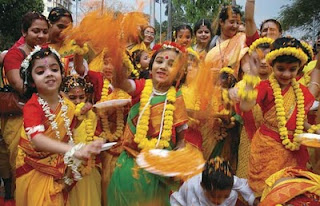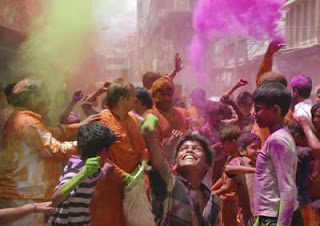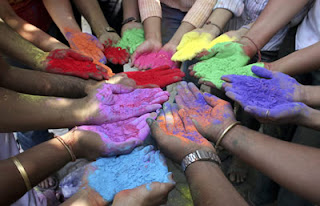Holi The Festival of Colors
Holi, is a festival of Colors, Love and Happiness in the Hindu religion. Celebration of Unity and celebrates the triumph of good over evil, generally falls on a full moon day in the month of March (Falgun). Originally a festival to celebrate good harvests and fertility of the land in India. Holi is the main festival of North India besides Deewali. Normally whole month of FALGUN (FAGUA) is dedicated to festival Holi.This exuberant festival is also associated with the immortal love of Krishna and Radha. There for the special celebration of Holi takes place at Braj region, in locations connected to the lord Krishna: ( Mathura , Vrindavan, Nandgoan , Barsana Etc). These places have become tourist destinations during the festive season of Holi, which lasts here to up to sixteen days. Holi is the 2nd largest festivals of the India which celebrating at every part and every region of the India by its own culture and by its own religion.
Holi is very oldest festival of hinduism which mentioned in MAHABHARATA , RAMAYANA and other Holy books too. Apart from the reference in the religious and historical texts, Holi also finds a reference in the sculptures on walls of old temples. A 16th century temple at Hampi, the capital of Vijayanagar (now in Karnataka) has a panel sculpted with the joyous scene of Holi celebrations. This painting illustrates a Prince and his Princess standing amidst maids who are waiting with pichkaris to drench the couple in colored water. Another painting on the theme related to Holi, the Vasanta Ragini - spring song or music is found in Ahmednagar in Maharashta. This 16th century painting depicts a royal couple sitting on a huge swing, and several maidens surrounding them playing music and spraying colors with pichkaris.
Holi has a detailed description in the ancient Vedas and Puranas such as ‘Narad Purana’ and ‘Bhavishya Purana’. The festival of Holi also finds detailed descriptions in the Jaimini Mimansa. During an excavation, a stone inscription of 300 BC was found at Ramgarh and this stone inscription has mention of ‘Holikotsav’ i.e. the ‘celebrations of Holi’ written on it. This gives logic to the theories of the historian who believe Holi to be a celebration even before the birth of Christ.
In RATNAVAL it mentioned “Witness the beauty of the great cupid festival which excites curiosity as the townsfolk are dancing at the touch of brownish water thrown from squirt guns. They are seized by pretty women while all along the roads the air in filled with singing and Drum-beating . Everything is colored yellowish red and rendered dusty by the heaps of scented powder blown all over “ RATNAVALI, 7th Century Drama.
The main legend of Celebration of Holi :
- It was on this day that Lord Siva opened his third eye and reduced Kamadev to ashes.
- It was on this day that Holika, the sister of the demon king Hiranyakasyapa, who tried to kill the child devotee Prahlad by taking him on her lap and sitting on a layer of woods which was set ablaze. Holika was burnt to ashes while Prahlad remained unscathed!
- It was again on this day that a Devil called Dhundhi, who was troubling the children in the kingdom of Prthu was made to run away for life, by the shouts and pranks of the mischievous boys. Though she had secured several boons that made her almost invincible, this – noise, shouts, abuses and pranks of boys – was a chink in her armour due to a curse of Lord Siva. The day itself came to be called ‘Holika’ since then.
The festival's preamble begins on the night of the full moon. Bonfires are lit on street corners to cleanse the air of evil spirits and bad vibes, and to symbolize the destruction of the wicked. Holika, for whom the festival was named.
The Legend of the Holika Dahan is :
Holika was a name of King Hiranyakasyapu was ambitious ruler, one who wanted absolute power so that he would be worshipped as God but the Kings Own son refused to obey his father King Hiranyakasyapu. Pralhad was a great devotee of Shree Vishnu/ NarayanaKing Hiranyakashyapu heard about the Prahlad's disobedience and decided to punish him severely. He asked his sister Holika for help.
It was believed that Holika was immune to fire and would never be burnt, so the King asked Holika to sit in the centre of a bonfire with Prahlad on her lap, so that the fire could devour him. The bonfire was lit, and young Prahlad sat in Holika's lap, in its centre, praying to Lord Vishnu. As “OM Namo Bhagvate Vasudevay Namah”. His devotion saved him, leaving him untouched by the flames, but Holika was burnt to ashes. To mark this legend, huge bonfires are lit on the eve of Holi.
Holika was a name of King Hiranyakasyapu was ambitious ruler, one who wanted absolute power so that he would be worshipped as God but the Kings Own son refused to obey his father King Hiranyakasyapu. Pralhad was a great devotee of Shree Vishnu/ NarayanaKing Hiranyakashyapu heard about the Prahlad's disobedience and decided to punish him severely. He asked his sister Holika for help.
It was believed that Holika was immune to fire and would never be burnt, so the King asked Holika to sit in the centre of a bonfire with Prahlad on her lap, so that the fire could devour him. The bonfire was lit, and young Prahlad sat in Holika's lap, in its centre, praying to Lord Vishnu. As “OM Namo Bhagvate Vasudevay Namah”. His devotion saved him, leaving him untouched by the flames, but Holika was burnt to ashes. To mark this legend, huge bonfires are lit on the eve of Holi.
A Holika Dahan preparation begins a month before the festival. People start collecting woods on the important crossroads of city. Holi Pooja takes place on an auspicious time in the evening a day before the Holi festival. Holi Pooja can be performed at any place. Collect and kept wood at public place on the day of Vasant Panchami with twigs, dried leaves, branches of trees .People light bonfires at night to celebrate the victory of 'good' over 'bad' which is called Holika Dahan.
The 2nd Day of holi is called as a Dhuleti. Day of Celebration with Color’s Abeer and Gulaal. Holi is the most energetic Indian festival, filled with fun and good humour; even the strict rules of separation between castes are abandoned is celebrated by people throwing colored powder and colored water at each other. Teenagers spend the day flirting and misbehaving in the streets, adults extend the hand of peace, and everyone chases everyone else around, throwing brightly colored powder (gulal) and water over each other. The following morning, the streets fill with people running, shouting, giggling and splashing. bhang and thandai add to the uninhibited atmosphere.
The colors of Holi, called 'gulal', were made at home, from the flowers of the 'tesu' or 'palash' tree, also called 'the flame of the forest'. These flowers, bright red or deep orange in color. This pigment and also 'aabir', made from natural colored talc, which were extensively used as Holi colors, are good for the skin. Food preparations also begin many days in advance, with assemblage of Gujhia, Sweets, kanji and various kinds of snack items including malpuas, mathri, puran poli, dahi badas, which are served to Holi guests.
It is celebrated on the fifth day (panchami) in the dark fortnight of the Hindu lunar month of Phalgun by throwing a red, fragrant powder (gulal) and splashing coloured water, etc. on others. Rang Panchami is a symbol of victory over raja-tama. Rang Panchami, played on Falgun Vadya Panchami involves invocation of Gods and is a part of worship of the manifest form of Gods. Its purpose is to activate the five elements of radiant manifest colours and to touch and feel the Deities who are attracted to the respective colours. These five elements are a source, which help activate the element of the Deities according to the spiritual emotion of the Jiva. Rang Panchami is the worship of the saviour form of the Deities.
Holi, very simply and unceremoniously reveals the golden key to happiness. The festival breaks all norms; it ignores all social inhibitions. For once, absolute freedom is given to human desires and senses. A day is given to live life as per one`s liking. From dancing like mad an singing loudly to using foul language, and from playing with colours to doing all mischief- one day in a year makes us small innocent kids.
Holi is not a festival-its freedom and so it must be celebrated and experienced-for this occasional balm is a must for our anxious, overworked and perplexed souls.
Holi in Brief :
- A spring festival, usually celebrated in March.
- Holi also celebrates Krishna, and the legend of Holika and Prahalad.
- Holi is particularly celebrated in North India.
- Although Holi has religious roots there are few religious things to do.
- Distinctions of caste, class, age, and gender are suspended during Holi.
- A very exuberant festival, with dancing, singing, and throwing of paint.
- Holi features gender rivalry, with contests between men and women, and public flirting.
- Bonfires are lit during Holi, and food offerings are roasted.
|| Radha Krishna Holi ||
















2 comments:
Happy holi to u all.....
नवरात्रि आरती संग्रह App Download Link- Navratri Aarti Sangrah
या देवी सर्वभूतेषु
शक्ति-रूपेण संस्थिता।
नमस्तस्यै नमस्तस्यै
नमस्तस्यै नमो नमः॥
आपको और आपके परिवारजनों को नवरात्रि की हार्दिक मङ्गलमय शुभकामनाये ।
नवरात्रि की 9 माताओं की आरती इस Android App में है
App Download Link- Navratri Aarti Sangrah
Post a Comment